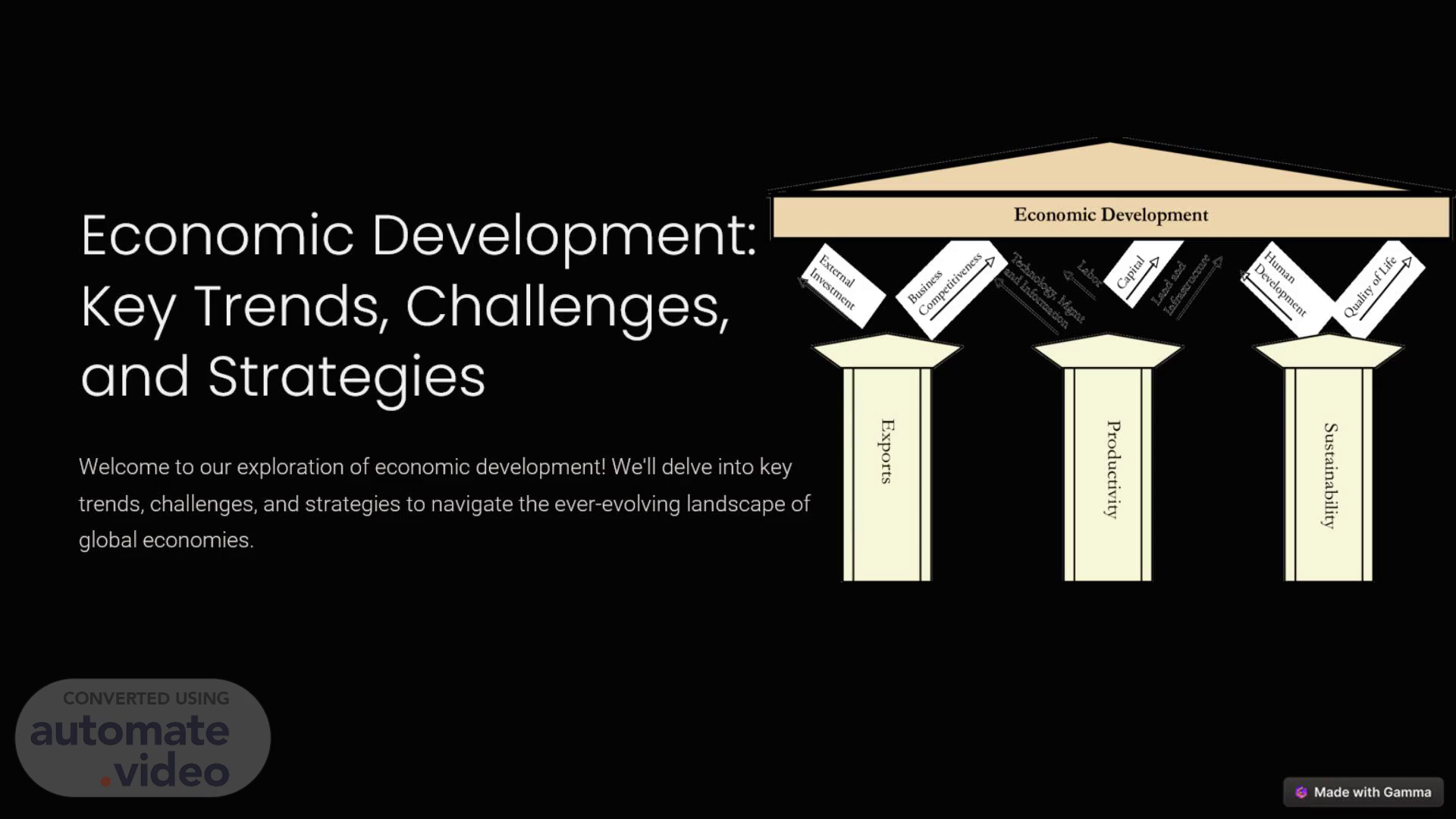Scene 1 (0s)
[Audio] Economic Development: Key Trends, Challenges, and Strategies Welcome to our exploration of economic development! We'll delve into key trends, challenges, and strategies to navigate the ever-evolving landscape of global economies..
Scene 2 (18s)
[Audio] Economic Sectors: Understanding the Shifting Landscape Primary Sector Secondary Sector Tertiary Sector Quaternary Sector Agriculture, mining, and forestry. These sectors provide raw materials essential for the production of goods and services. Manufacturing, construction, and utilities. This sector transforms raw materials into finished products, contributing to national output and employment. Services, including finance, healthcare, education, and tourism. This sector focuses on providing services to individuals and businesses, driving economic growth and employment. Knowledge-based activities like research and development, technology, and information services. This sector is becoming increasingly crucial for innovation and global competitiveness..
Scene 3 (1m 11s)
[Audio] National Income and GDP: Measuring Economic Progress GDP National Income The total value of goods and services produced by a nation, including wages, profits, and rents. The total market value of all final goods and services produced within a country in a specific time period. GDP, the most popular way to measure economic growth, is calculated by adding up all of the money spent by consumers, businesses, and the government in a given period. The formula is: GDP = consumer spending + business investment + government spending + net exports..
Scene 4 (1m 55s)
[Audio] Growth vs. Development: Balancing Priorities Growth An increase in a country's output of goods and services over time. Measured by GDP. Development A broader concept that encompasses improvements in living standards, education, healthcare, and social well-being..
Scene 5 (2m 16s)
[Audio] The Impact of Globalization: Opportunities and Risks Trade Increased international trade opens up new markets and expands economic opportunities. Investment Foreign direct investment can bring in capital, technology, and expertise, boosting economic growth. Competition Increased competition from foreign companies can challenge domestic firms and industries. Job Displacement Globalization can lead to job losses in some sectors as companies relocate production to lower-cost countries..
Scene 6 (2m 52s)
[Audio] Economic Problems: Identifying and Addressing Challenges Unemployment Inflation A lack of job opportunities for willing and able workers, impacting economic output and social well-being. A sustained increase in the general price level of goods and services, eroding purchasing power and making it challenging for businesses to plan for the future. Poverty Inequality A lack of basic needs and resources, including food, shelter, healthcare, and education. The unequal distribution of wealth and resources, creating social divisions and undermining economic stability..
Scene 7 (3m 34s)
[Audio] Policy Interventions: Fostering Economic Prosperity Fiscal Policy Government spending and taxation policies to influence economic activity. Monetary Policy Central bank policies, such as interest rates and money supply, to manage inflation and stimulate growth. Trade Policy Policies that regulate international trade, including tariffs and quotas. Investment Policy Policies that attract foreign direct investment and stimulate domestic investment. Human Capital Development Policies that invest in education, training, and healthcare to improve the skills and productivity of the workforce..
Scene 8 (4m 15s)
[Audio] Technological Innovation: Driving Economic Transformation Automation Digitalization The use of robots and artificial intelligence to perform tasks previously done by humans. The use of digital technologies to transform businesses and industries. Research and Development Investing in new technologies and scientific breakthroughs to drive innovation and economic growth..
Scene 9 (4m 43s)
[Audio] Sustainable Development: Balancing Growth and the Environment Clean Energy Circular Economy Transitioning to renewable energy sources to reduce carbon emissions and combat climate change. Adopting a circular economic model that minimizes waste and promotes resource efficiency. Green Technologies Developing and implementing environmentally friendly technologies to minimize environmental impact..
Scene 10 (5m 8s)
[Audio] Conclusion: Charting a Path Forward By embracing innovation, promoting inclusivity, and fostering sustainable practices, we can create a future where economic growth and social progress go hand in hand, ensuring a brighter and more prosperous world for all..
Scene 11 (5m 26s)
[Audio] THANKYOU. THANKYOU.
